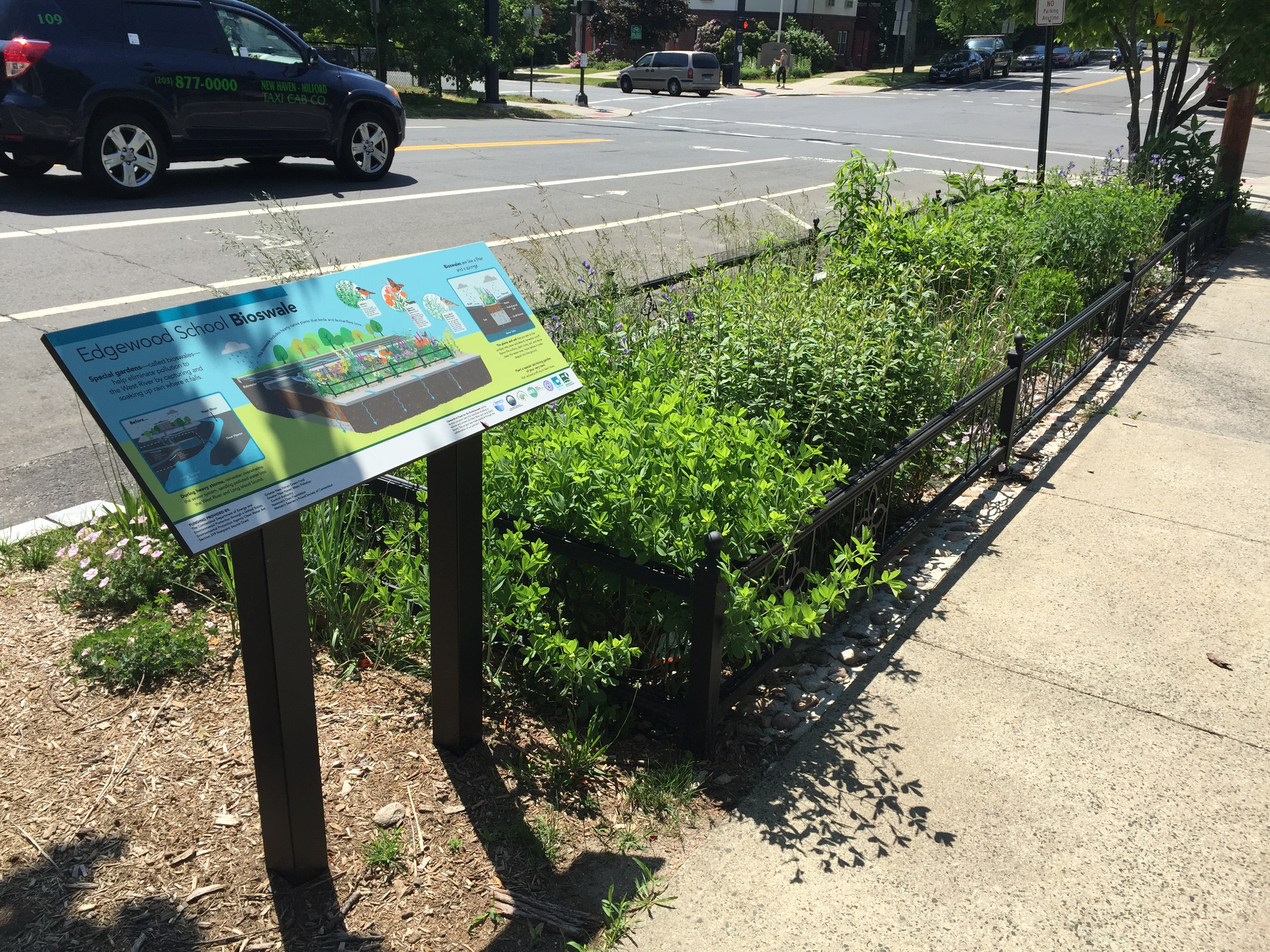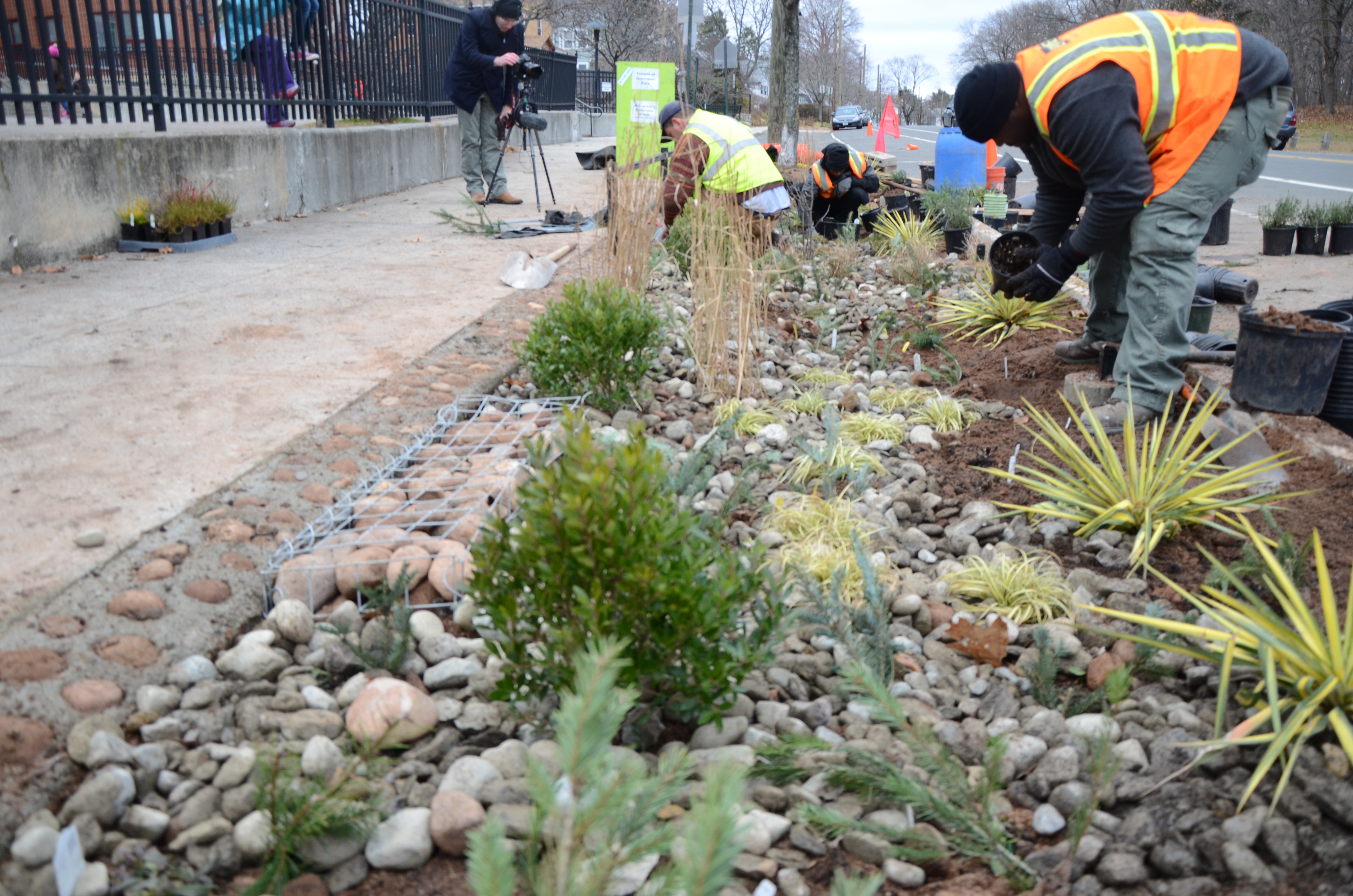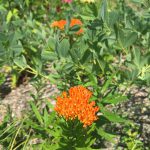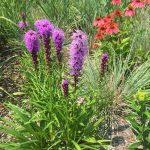During World Water Week last week, we spent a lot of time thinking about how smart management of stormwater is a key part of building sustainable communities for the future. We shared stories about rain gardens and the importance of preventing polluted stormwater runoff from reaching rivers and streams that feed into Long Island Sound. Our green infrastructure projects are designed to address the water-related challenges unique to urban areas.
This week, we’re thinking about another green infrastructure project designed to curb stormwater pollution while replenishing groundwater: the Edgewood School bioswale in New Haven. A bioswale serves a similar function to a rain garden by slowing flooding and filtering stormwater runoff, but bioswales are generally deeper than rain gardens and designed to handle runoff from large, paved surface areas like roadways and parking lots.

The Edgewood School bioswale was designed to manage the last section of a combined storm-sanitary sewer on Yale Avenue, on the west side of the West River. Combined sewers carry stormwater runoff (rain that falls on roof tops, road ways, and other hard surfaces, and flows into storm drains around the city) and sanitary sewage (what you flush down the toilet or send down the kitchen sink) in the same pipes.
 On a sunny day in New Haven, all of the water in the pipes flows to a wastewater treatment plant to be cleaned before being released into the New Haven Harbor. When it rains, however, all of the hard surfaces in the city produce an excess of stormwater runoff and cause the combined storm-sanitary pipes to fill up quickly. During some rain storms, neither the pipes nor the treatment plant can handle all of the water that flows into them, and the pipes—designed to overflow—release stormwater and sewage, untreated, into the our rivers and the Long Island Sound (you might hear this called a CSO, for “combined sewer overflow”). The 280-square-foot Edgewood bioswale manages over 11,000 square feet of impervious roadway, filtering over 300,000 gallons of rainwater annually.
On a sunny day in New Haven, all of the water in the pipes flows to a wastewater treatment plant to be cleaned before being released into the New Haven Harbor. When it rains, however, all of the hard surfaces in the city produce an excess of stormwater runoff and cause the combined storm-sanitary pipes to fill up quickly. During some rain storms, neither the pipes nor the treatment plant can handle all of the water that flows into them, and the pipes—designed to overflow—release stormwater and sewage, untreated, into the our rivers and the Long Island Sound (you might hear this called a CSO, for “combined sewer overflow”). The 280-square-foot Edgewood bioswale manages over 11,000 square feet of impervious roadway, filtering over 300,000 gallons of rainwater annually.
It’s also important to remember that green infrastructure and sustainable water management are about more than just filtering water. They’re also about providing other valuable services to the community, from de-paving and softening the cityscape to creating local jobs and providing wildlife habitat. The multidimensional benefits of green infrastructure projects like the Edgewood School bioswale boost an ecosystem’s resilience while improving the water quality of nearby streams and rivers.
Outside the Edgewood Magnet School in New Haven, we broke ground on an 8-foot area of cement sidewalk back in 2014. With help of the City of New Haven Engineering Department, the Urban Resources Initiative, and the Emerge workforce re-entry crew, we planned and constructed the bioswale and filled it with native grasses, sedges, and other perennials known for their climatic resilience and ability to attract birds and pollinators.

During our most recent visit to the Edgewood School bioswale on August 25, we spotted a goldfinch enjoying the garden’s leafy cover and increasingly lush flowers.
Plants in the bioswale include Joe Pye Weed, Yellow Coneflower, and Purple Coneflower (Echinacea).
We’ve enjoyed watching the bioswale’s greenery develop and thrive. We recently received a contract to build four more bioswales in New Haven’s West River Watershed over the next year. The Edgewood School bioswale and the new bioswales are funded in part by a US EPA Section 319 grant, administered by the Connecticut Department of Energy and Environmental Protection.
For more information about bioswales, rain gardens, and our green infrastructure projects, visit our dedicated green infrastructure website at ReduceRunoff.org.




2 thoughts on “Green Infrastructure in New Haven: Bioswales and the West River”
Comments are closed.